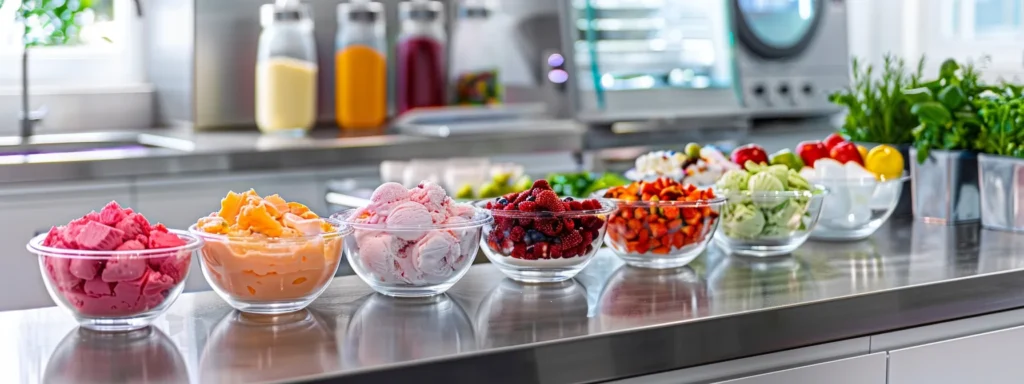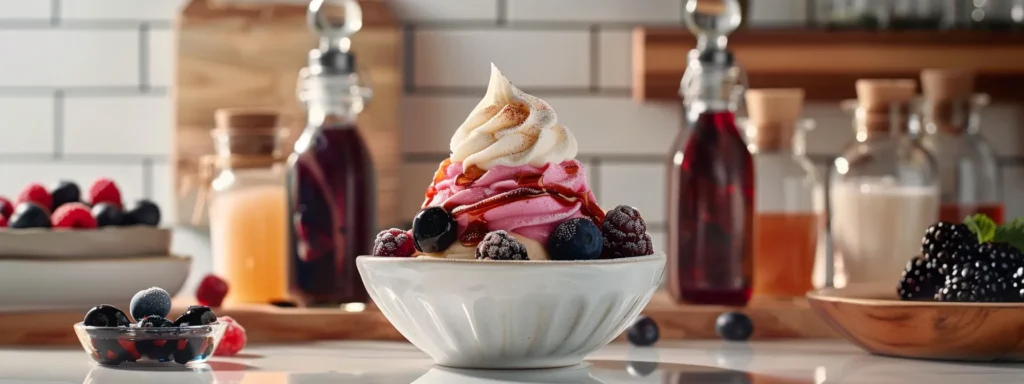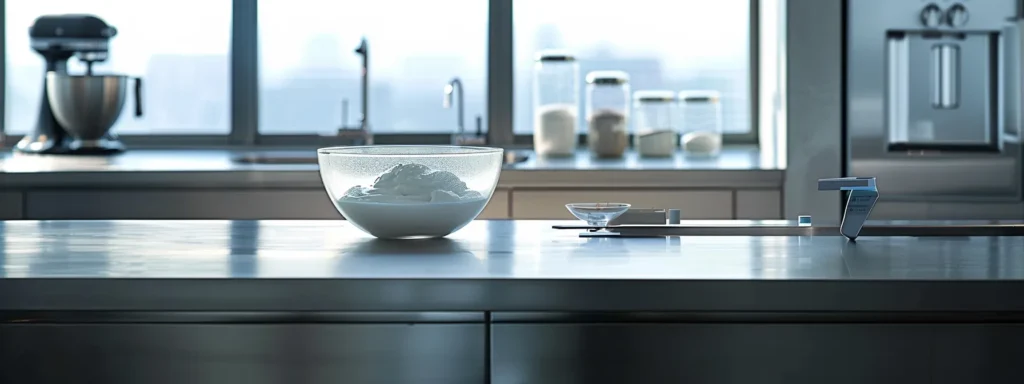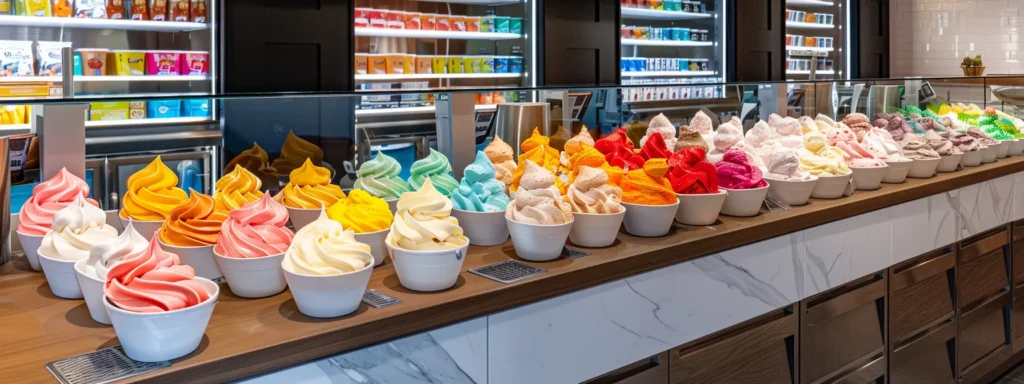
Table Of Contents:
- Frozen Yogurt Recipe Tips for Perfect Texture
- Key Takeaways
- Selecting Your Base Yogurt for Optimal Creaminess
- Balancing Sweeteners to Prevent Ice Crystals
- Adding Stabilizers for a Silky Smooth Finish
- Preparing Your Frozen Yogurt Base Correctly
- Mastering the Churning and Freezing Stage
- Storing and Serving for Best Frozen Yogurt Texture
- Conclusion
Frozen Yogurt Recipe Tips for Perfect Texture
Are you tired of icy, grainy frozen yogurt that just doesn’t hit the spot? Achieving the perfect texture can be tricky, but it doesn’t have to be. In this guide, you’ll learn how to choose the right base yogurt, balance sweeteners to avoid ice crystals, and use stabilizers for that creamy finish. By following these tips, you’ll create a frozen yogurt that’s not only delicious but also has the smooth texture you crave, making your homemade treats a hit every time.
Key Takeaways
- Choosing the right yogurt base greatly affects the texture of frozen yogurt
- Straining regular yogurt creates a thicker consistency similar to Greek yogurt
- Sugar lowers the freezing point, preventing ice crystals for a creamier dessert
- Chilling the mixture enhances flavor development and ensures a smoother texture
- Proper storage methods maintain consistency and prevent freezer burn in frozen yogurt
Selecting Your Base Yogurt for Optimal Creaminess

When choosing your base yogurt for frozen yogurt, consider how fat content impacts your mixture’s final texture. Opt for full-fat yogurt for a richer mouthfeel, or Greek yogurt for added density and tang. If you prefer regular yogurt, straining it can increase thickness. Incorporating cream or milk also enhances smoothness, creating a more delightful treat with the perfect balance of sugar and the right bacteria for flavor.
Understand How Fat Content Affects Frozen Yogurt Texture
Understanding how fat content influences the texture of your frozen yogurt is essential. Higher fat levels create a creamier consistency, reducing ice crystal formation during freezing, leading to a smoother treat. For a successful mix, consider incorporating cultures like streptococcus thermophilus to enhance flavor, while letting your base yogurt sit at room temperature before mixing helps achieve a balanced texture, making your homemade frozen yogurt a delightful recipe from your favorite cookbook.
Choose Full-Fat Yogurt for Richer Results
Choosing full-fat yogurt for your frozen yogurt base significantly enhances the richness of your dessert. This type of yogurt not only adds a creamy texture, but it also offers beneficial nutrients such as probiotics, which support gut health, and vitamins that contribute to your overall nutrition. If you want to boost the fiber content of your treat, consider blending in peanut butter, creating a deliciously nutritious option that satisfies your cravings while being healthy.
Consider Greek Yogurt for Density and Tang
Using Greek yogurt as a base for your frozen yogurt not only enhances the creaminess but also introduces a delightful tang that balances flavors. The natural acids in Greek yogurt help cut through the sweetness of any added sugar, making it a perfect companion for fruit-based popsicles. When blending Greek yogurt in a food processor, you can easily incorporate any extra flavors such as fruit puree and reduce the whey for a denser mixture that maintains a smooth texture when frozen.
Strain Regular Yogurt to Mimic Greek Yogurt Thickness
To enhance the thickness of regular yogurt and achieve a texture similar to Greek yogurt, straining is an effective technique. By removing excess whey, you will create a denser mixture that can elevate your frozen yogurt recipe. This thicker base pairs exceptionally well with whipped cream and vanilla extract, allowing for a rich and flavorful dessert. Additionally, replacing some of the yogurt with a splash of buttermilk will introduce a smoothness that complements various flavoring options.
| Technique | Description | Benefits |
|---|---|---|
| Strain Regular Yogurt | Remove excess whey using a cheesecloth or fine mesh sieve. | Creates a thicker texture, similar to Greek yogurt. |
| Incorporate Whipped Cream | Fold in whipped cream for added creaminess. | Enhances texture and gives a rich flavor. |
| Use Vanilla Extract | Add a few drops to enhance flavor. | Improves taste profile, balancing sweetness. |
| Mix in Buttermilk | Replace some yogurt with buttermilk. | Creates a smooth consistency and adds tang. |
| Experiment with Flavoring | Add fruit or other flavoring agents into the mixture. | Customizes your frozen yogurt recipe to personal preference. |
Incorporate Cream or Milk for Added Smoothness
Incorporating cream or milk into your frozen yogurt base can significantly enhance the overall smoothness and richness of your frozen dessert. Choosing full-fat options will contribute to a creamier texture, enriching the taste while balancing the sweetness of added flavorings like maple syrup. By adjusting the fat content through these ingredients, you not only improve texture but also elevate the sensory experience, making each bite a delightful treat that meets your craving for a deliciously satisfying yogurt.
Balancing Sweeteners to Prevent Ice Crystals

Recognizing sugar‘s role in lowering the freezing point of strained yogurt is essential for creating a smooth texture in your frozen treat. Use liquid sweeteners like honey or agave with caution, as they can affect consistency. Combine different sugars, such as maple syrup, to achieve your desired sweetness and texture while avoiding substitutes that may freeze too hard. These insights will guide you in crafting a delightful yogurt experience.
Recognize Sugar's Function in Lowering Freezing Point
Understanding the role of sugar in your frozen yogurt mixture is essential for achieving the perfect texture. Sugar not only sweetens your dessert but also lowers the freezing point, which helps prevent ice crystals from forming and keeps your frozen yogurt creamy. For instance, using brown sugar can enhance the flavor profile while providing that essential sweet touch, and if you’re looking for alternatives, incorporating almond milk or making a pudding base can also deliver a satisfying, low-calorie treat that aligns with your dietary preferences.
Use Liquid Sweeteners Like Honey or Agave Carefully
When adding liquid sweeteners like honey or agave to your frozen yogurt, be mindful of their effects on texture. These sweeteners can lower the freezing point, which is crucial for maintaining a creamy consistency. If you intend to infuse flavors from lime or berry, consider balancing the sweetness with a touch of corn syrup to prevent ice crystals from forming, ensuring each spoonful remains smooth and satisfying. You could also use an Instant Pot to streamline your yogurt-making process while maintaining optimal texture.
Combine Different Sugars for Better Texture Control
Combining different sugars can significantly improve the texture of your frozen yogurt. For instance, if you are making a tart lemon yogurt, mixing granulated sugar with brown sugar can provide a nuanced flavor and help maintain a creamy consistency. Similarly, if you’re creating a chocolate chip version, incorporating a bit of corn syrup can work wonders in preventing ice crystals, ensuring that each spoonful is smooth and satisfying.
Adjust Sweetness Levels to Suit Your Taste and Texture Goals
When creating frozen yogurt, adjusting sweetness levels is essential for achieving the ideal taste and texture. Using a balance of carbohydrates, such as sugar and starch, can help you tailor the sweetness to your preferences. For instance, if you’re working with a quart of yogurt, incorporating vanilla and a touch of starch can enhance both flavor and creaminess, while preventing ice crystals. This attention to detail ensures a smoother and more enjoyable dessert experience.
Avoid Sugar Substitutes That May Freeze Hard
When creating your frozen yogurt, avoid sugar substitutes that may freeze too hard, as they can lead to an undesirable texture. Certain ingredients, like some artificial sweeteners, can make your mixture overly firm, which diminishes the creamy quality you aim for. Stick with natural sweeteners that incorporate easily; a simple combination of sugar and salt may yield smoother results, so use a whisk to blend them well in your mixing bowl, ensuring a delightful vanilla ice cream-like texture that everyone will enjoy.
Adding Stabilizers for a Silky Smooth Finish

To achieve a silky smooth finish in your frozen yogurt, consider using natural stabilizers like egg yolks for a rich base. Cornstarch slurry can add thickness, while gelatin improves body and melt resistance. Incorporating xanthan gum or guar gum in small amounts can enhance texture, and cream cheese can provide a delightful tang paired with creaminess. Each of these methods contributes to a soft serve experience that elevates your dairy dessert.
Introduce Natural Stabilizers Like Egg Yolks
Incorporating natural stabilizers like egg yolks into your frozen yogurt can significantly enhance its texture, creating a creamier and silkier finish. This technique not only helps prevent ice crystal formation but also adds richness that complements flavors such as peanut butter or fruit blends. By using a slow cooker to temper the yolks before mixing them into your yogurt base, you can achieve the optimal consistency for a delightful diet food that feels indulgent yet light.
Use Cornstarch Slurry for Thickness
Using a cornstarch slurry is an effective method for adding thickness to your frozen yogurt. To create this slurry, mix equal parts cornstarch and cold water, then gradually heat it in a saucepan until it thickens, ensuring you monitor the temperature with a thermometer. This thickening agent can improve the texture, allowing your yogurt to have a creamier mouthfeel while still maintaining lower levels of saturated fat, making it a healthier option when combined with ingredients like coconut and a dash of agave for sweetness.
| Ingredient | Function | Benefits |
|---|---|---|
| Cornstarch | Thickening agent | Improves texture, contributes to creamy mouthfeel. |
| Coconut | Flavor enhancer | Adds richness and a unique taste. |
| Agave | Natural sweetener | Provides sweetness with a lower glycemic index. |
| Vitamin A | Nutritional boost | Supports overall health and wellness. |
Add Gelatin for Improved Body and Melt Resistance
Adding gelatin to your frozen yogurt recipe can greatly improve the body and melt resistance of your dessert. By incorporating just one tablespoon of gelatin, you help to prevent ice crystals from forming, resulting in a smoother texture that mimics well-known brands like Pinkberry. Gelatin also enhances the creaminess by binding with the lactic acid present, contributing to the overall mouthfeel while increasing the calcium content of your treat.
| Ingredient | Benefit | Usage Tips |
|---|---|---|
| Gelatin | Improves body and melt resistance | Add one tablespoon to your mixture for best results. |
| Lactic Acid | Enhances flavor | Use in moderation to balance tartness. |
| Calcium | Supports bone health | Includes yogurt and milk sources for added benefits. |
Incorporate Xanthan Gum or Guar Gum Sparingly
Incorporating xanthan gum or guar gum into your frozen yogurt recipe can improve texture, but it’s essential to use these stabilizers sparingly. A pinch can enhance creaminess without overwhelming your mixture, allowing it to blend seamlessly with flavors like syrup or cream. When making a fruity sorbet, a small amount of these gums can also help maintain a smooth consistency, ensuring that your dessert remains enjoyable even after freezing. This careful balance will lead to a delightful treat that impresses your palate:
| Stabilizer | Benefit | Usage Tips |
|---|---|---|
| Xanthan Gum | Enhances creaminess and texture | Add a pinch to your mixture for best results. |
| Guar Gum | Improves smoothness in frozen desserts | Use sparingly to avoid a gummy texture. |
| White Wine | Adds unique flavor | Incorporate in moderation for an interesting twist. |
Try Cream Cheese for Tang and Creaminess
Incorporating cream cheese into your frozen yogurt can add a delightful tang while also enhancing creaminess. This ingredient not only helps improve the texture but also brings a rich flavor that complements various mix-ins, such as fruit or chocolate. For best results, ensure you blend cream cheese thoroughly into the yogurt base to create a smooth, luxurious mouthfeel in your homemade frozen yogurt:
| Ingredient | Function | Benefits |
|---|---|---|
| Cream Cheese | Adds tang and creaminess | Enhances texture and flavor profile. |
| Yogurt | Main base | Provides a healthy foundation and probiotic benefits. |
| Mix-Ins | Flavor enhancement | Allows customization and variety in your dessert. |
Preparing Your Frozen Yogurt Base Correctly

To create a perfectly textured frozen yogurt, ensure all your ingredients are fully dissolved before starting. Chill your mixture thoroughly to enhance flavor and consistency, and strain the base to remove any potential solids for a smoother finish. Allowing flavors to meld during the chilling period will elevate the overall taste, resulting in a delightful dessert experience.
Ensure All Ingredients Are Fully Dissolved
To achieve the best texture for your frozen yogurt, it’s crucial to ensure that all ingredients are fully dissolved before freezing. This step minimizes any potential graininess, allowing for a smoother, creamier final product. Taking the time to mix your ingredients well can make all the difference, resulting in a delightful frozen treat that everyone will enjoy:
| Step | Action | Benefit |
|---|---|---|
| Mix Thoroughly | Stir all ingredients until combined. | Ensures a uniform flavor and texture. |
| Check for Solids | Strain the mixture to remove any lumps. | Prevents graininess in the final product. |
| Chill Mixture | Refrigerate before freezing. | Enhances flavor development and texture. |
Chill Your Mixture Thoroughly Before Churning
Chilling your yogurt mixture thoroughly before churning is a crucial step for achieving a smooth and creamy frozen yogurt texture. By allowing your mixture to rest in the refrigerator for at least two hours, you enhance flavor development and ensure proper freezing during the churning process. This not only minimizes ice crystal formation but also results in a delightful dessert that meets your expectations for both taste and consistency.
Strain the Base to Remove Any Potential Solids
Straining your yogurt base is a crucial step to eliminate any potential solids that could disrupt the smooth texture of your frozen yogurt. By using a fine mesh sieve or cheesecloth, you can ensure a silky consistency, enhancing the overall mouthfeel of your dessert. This simple technique not only improves the final product but also ensures that each spoonful is as enjoyable as possible, helping you achieve that perfect creamy texture everyone desires.
Allow Flavors to Meld During the Chilling Period
Allowing flavors to meld during the chilling period is essential for achieving a harmonious taste in your frozen yogurt. By refrigerating your yogurt mixture for a few hours, you enable the ingredients to combine fully, enhancing the overall flavor profile. This step is particularly important when using fruits or flavor extracts, as it ensures that each bite of your frozen treat delivers a well-rounded and satisfying experience.
Mastering the Churning and Freezing Stage

To achieve the perfect texture in your frozen yogurt, it’s vital to follow your ice cream maker’s instructions closely. Avoid overfilling the bowl to ensure proper churning, and recognize signs that indicate your yogurt is adequately churned. Transfer your mix to an airtight freezer container promptly after churning. If you lack an ice cream maker, you’ll find tips for achieving great texture without one beneficial.
Follow Your Ice Cream Maker's Instructions Precisely
To achieve the ideal texture for your frozen yogurt, it is crucial to follow your ice cream maker‘s instructions precisely. Each model operates differently, and adhering to the recommended settings ensures optimal churning and freezing. For example, avoid overfilling the bowl, as this can impede the movement necessary to create a smooth and creamy consistency. Familiarizing yourself with your ice cream maker‘s features will guide you to the best results:
| Step | Action | Benefit |
|---|---|---|
| Check Capacity | Ensure the bowl isn’t overfilled. | Prevents inefficient churning. |
| Use Recommended Settings | Follow the ice cream maker’s settings | Optimizes churning and freezing process. |
| Monitor Churning Time | Watch for signs of proper texture. | Aids in achieving smooth yogurt. |
Avoid Overfilling the Ice Cream Maker Bowl
Avoiding overfilling the ice cream maker bowl is crucial for achieving a smooth and creamy frozen yogurt texture. When the bowl is too full, it can prevent proper churning, leading to uneven consistency and ice crystal formation. To ensure the best results, always measure your mixture according to the manufacturer’s guidelines, allowing enough space for the yogurt to expand and churn effectively.
Recognize the Signs of Properly Churned Frozen Yogurt
To recognize properly churned frozen yogurt, keep an eye on its texture and consistency. You’re looking for a smooth, thick mixture that holds its shape when you remove it from the ice cream maker. If it appears fluffy and forms soft peaks, it’s likely ready to be transferred to an airtight container for freezing, ensuring each scoop has the creamy texture you desire for a perfect frozen treat.
Transfer Immediately to an Airtight Freezer Container
Once you achieve the desired texture in your frozen yogurt, transferring it immediately to an airtight freezer container is essential. This step helps lock in the creamy consistency while preventing any unwanted ice crystal formation. By sealing your frozen yogurt properly, you ensure that it stays smooth, fresh, and ready to satisfy your cravings whenever you’re ready to indulge:
| Step | Action | Benefit |
|---|---|---|
| Prepare Container | Have an airtight container ready. | Keeps yogurt fresh and creamy. |
| Transfer Quickly | Move yogurt from the ice cream maker to the container swiftly. | Minimizes exposure to air and temperature changes. |
| Seal Tightly | Close the container securely. | Prevents freezer burn and ice crystals. |
Tips for Achieving Good Texture Without an Ice Cream Maker
If you don’t have an ice cream maker, you can still achieve optimal texture in your frozen yogurt by using a simple method. Begin by placing your blended yogurt mixture in a shallow container and freeze it for about 30 minutes. Then, remove it from the freezer and stir it vigorously with a fork or whisk every 30 minutes until it reaches a creamy consistency; this will help break up ice crystals and create a smoother texture. These steps ensure that your homemade frozen yogurt remains creamy and satisfying:
| Step | Action | Benefit |
|---|---|---|
| Freeze Mixture | Place yogurt in a shallow container and freeze for 30 minutes. | Initial freeze helps start the texture process. |
| Stir Regularly | Remove and stir the mixture every 30 minutes. | Breaks up ice crystals for creamier yogurt. |
| Serve When Ready | Once creamy, it’s ready to enjoy. | Avoids hard texture and enhances flavor experience. |
Storing and Serving for Best Frozen Yogurt Texture

To achieve the best texture for your frozen yogurt, it’s essential to follow a few key steps. Ensure you harden your yogurt in the freezer for the right amount of time and temper it before scooping for easier serving. Utilize proper scooping techniques to avoid damage and learn effective storage methods to prevent freezer burn. If your frozen yogurt becomes too solid, a quick processing before serving can refresh its texture.
Harden in the Freezer for the Right Amount of Time
To achieve the perfect texture in your frozen yogurt, it’s crucial to harden it in the freezer for an appropriate duration. If you remove it from the ice cream maker too soon, it may not set properly, resulting in a grainy or icy texture. Aim to freeze your yogurt for at least four hours, but allowing it to rest overnight will enhance the overall creaminess, making it a delightful treat when ready to serve.
Temper Frozen Yogurt Before Scooping
Before scooping your frozen yogurt, it’s essential to temper it for optimal texture. Allow it to sit at room temperature for about 5 to 10 minutes, which softens the yogurt and makes it easier to serve. This simple step ensures that you enjoy a creamy and smooth serving, rather than struggling with a rock-hard dessert that compromises the delightful experience you aim for.
Use Proper Scooping Techniques for Hard Frozen Yogurt
Using proper scooping techniques for hard frozen yogurt can significantly enhance your serving experience. Start by allowing your frozen yogurt to temper at room temperature for about 5 to 10 minutes, which softens it slightly and makes scooping easier. When you do scoop, using a warm ice cream scoop or a sturdy spoon will help create smooth, even servings, ensuring that each scoop delivers the creamy texture you aimed for in your recipe.
Prevent Freezer Burn With Proper Storage Methods
To prevent freezer burn and maintain the delightful texture of your frozen yogurt, proper storage methods are crucial. Start by transferring your yogurt into an airtight container, which helps minimize air exposure that can lead to ice crystals forming on the surface. For optimal results, wrap the container in plastic wrap before sealing it to add an extra layer of protection, ensuring your frozen yogurt remains smooth and creamy for as long as possible:
| Storage Method | Description | Benefits |
|---|---|---|
| Airtight Container | Use a container that seals tightly to prevent air entry. | Reduces freezer burn and maintains texture. |
| Plastic Wrap | Wrap the container before sealing for added protection. | Enhances moisture retention for creamy yogurt. |
| Freeze in Small Portions | Store yogurt in smaller containers for quicker access. | Minimizes temperature fluctuations during storage. |
Refresh Texture by Briefly Processing Before Serving
If your frozen yogurt becomes too solid in the freezer, you can refresh its texture easily before serving. Simply take the yogurt out and process it briefly in a blender or food processor for 30 seconds to a minute. This quick method helps break up any ice crystals, resulting in a smoother and creamier final product that enhances your enjoyment of this tasty treat.
Conclusion
Creating the perfect frozen yogurt requires attention to detail, particularly regarding ingredients and techniques that enhance texture. Selecting the right yogurt base, carefully balancing sweeteners, and incorporating stabilizers are essential steps to achieve a creamy final product. Thoroughly chilling your mixture and precise churning practices further contribute to a delightful dessert experience. By following these tips, you ensure each scoop of your homemade frozen yogurt is smooth, satisfying, and a fantastic treat to enjoy.